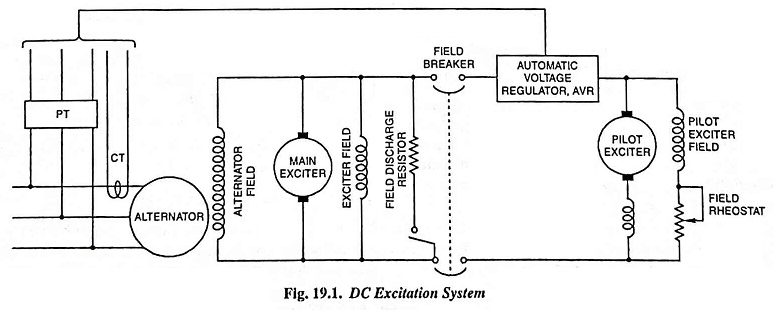DC Excitation System Working Principle:
In dc excitation system, the system has two exciters—the main exciter (a separately excited dc generator providing the field current to the alternator) and a pilot exciter (a compound wound self excited dc generator providing the field current to the main exciter). The exciter output is regulated by an automatic voltage regulator (AVR) for controlling the output terminal voltage of the alternator.
The current transformer input to the AVR ensures limiting of alternator current during fault. With the opening of field breaker, the field discharge resistor is connected across the field winding so as to dissipate the stored energy in the field winding which is highly inductive. The main and pilot exciters can be either driven by the main shaft (directly or through gearing) or separately driven by a motor. Direct driven exciters are usually preferred as these preserve the unit system of operation and the excitation is not affected by external disturbances.
Exciters for small sized turbo-alternators are usually directly coupled to the shaft whereas for medium and large size turbo-alternators, the exciters are coupled to the main shaft through gear and are usually driven at 1,000 rpm. The voltage rating of the main exciter is about 400 V and its capacity is about 0.5% of the capacity of the alternator. Troubles in the exciters of turbo-alternators are quite frequent because of their high speeds and as such separate motor driven exciters are provided as standby exciters.
In some cases the dc excitation system is equipped with amplidyne controller. The amplidyne is a high response cross-field dc generator, which has a very high amplification factor andrequires very small control power. It is supplied from an automatic voltage regulator (AVR). The main shortcomings of dc excitation system are large time constant (around 3 seconds) and commutation difficulties. As such the dc excitation systems have been superseded by ac excitation systems and static systems.
